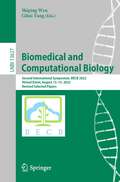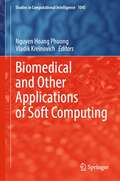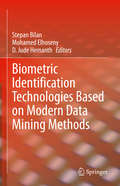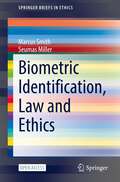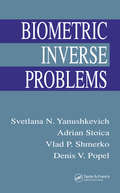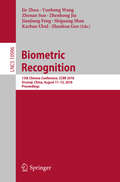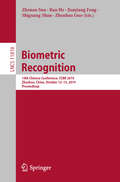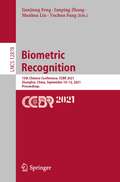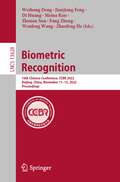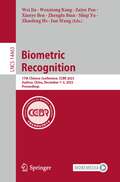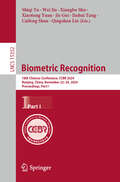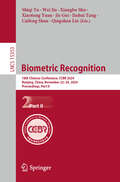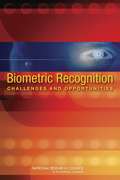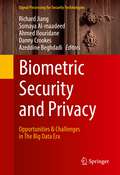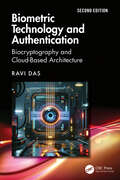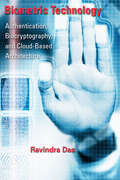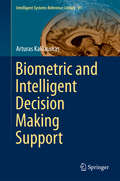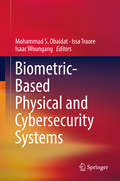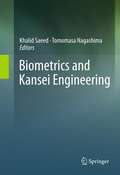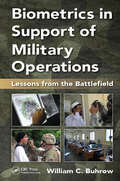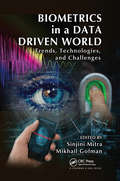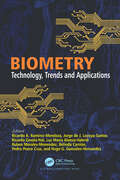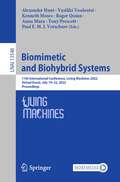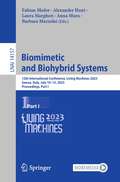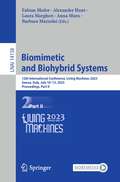- Table View
- List View
Biomedical and Computational Biology: Second International Symposium, BECB 2022, Virtual Event, August 13–15, 2022, Revised Selected Papers (Lecture Notes in Computer Science #13637)
by Shiping Wen Cihui YangThis book constitutes the revised selected proceedings of Second International Symposium on Biomedical and Computational Biology, BECB 2022, held as a virtual event in August 2022.The 58 full papers included in this book were carefully reviewed and selected from 135 submissions. The papers are organized in topical sections as follows: The Charge Transfer Network Model for Arbitrary Proteins Complexes; A Self-Supervised 3D/2D Registration Method for Incomplete DSA Vessels; The Potential Role of RNA "Writer" TRMT61B in the Immune Regulation of Breast Cancer; Extraction, Composition Analysis and Blood Lipid Lowering Activity of Rana chensinensis Ovum Oil.
Biomedical and Other Applications of Soft Computing (Studies in Computational Intelligence #1045)
by Vladik Kreinovich Nguyen Hoang PhuongThis book describes current and potential use of artificial intelligence and computational intelligence techniques in biomedicine and other application areas. Medical applications range from general diagnostics to processing of X-ray images to e-medicine-related privacy issues. Medical community understandably prefers methods that have been successful other on other application areas, where possible mistakes are not that critical. This book describes many promising methods related to deep learning, fuzzy techniques, knowledge graphs, and quantum computing. It also describes the results of testing these new methods in communication networks, education, environmental studies, food industry, retail industry, transportation engineering, and many other areas. This book helps practitioners and researchers to learn more about computational intelligence methods and their biomedical applications—and to further develop this important research direction.
Biometric Identification Technologies Based on Modern Data Mining Methods
by Mohamed Elhoseny D. Jude Hemanth Stepan BilanThis book emphasizes recent advances in the creation of biometric identification systems for various applications in the field of human activity. The book displays the problems that arise in modern systems of biometric identification, as well as the level of development and prospects for the introduction of biometric technologies. The authors classify biometric technologies into two groups, distinguished according to the type of biometric characteristics used. The first group uses static biometric parameters: fingerprints, hand geometry, retina pattern, vein pattern on the finger, etc. The second group uses dynamic parameters for identification: the dynamics of the reproduction of a signature or a handwritten keyword, voice, gait, dynamics of work on the keyboard, etc. The directions of building information systems that use automatic personality identification based on the analysis of unique biometric characteristics of a person are discussed. The book is intended for professionals working and conducting research in the field of intelligent information processing, information security, and robotics and in the field of real-time identification systems. The book contains examples and problems/solutions throughout.
Biometric Identification, Law and Ethics (SpringerBriefs in Ethics)
by Seumas Miller Marcus SmithThis book is open access. This book undertakes a multifaceted and integrated examination of biometric identification, including the current state of the technology, how it is being used, the key ethical issues, and the implications for law and regulation. The five chapters examine the main forms of contemporary biometrics–fingerprint recognition, facial recognition and DNA identification– as well the integration of biometric data with other forms of personal data, analyses key ethical concepts in play, including privacy, individual autonomy, collective responsibility, and joint ownership rights, and proposes a raft of principles to guide the regulation of biometrics in liberal democracies.Biometric identification technology is developing rapidly and being implemented more widely, along with other forms of information technology. As products, services and communication moves online, digital identity and security is becoming more important. Biometric identification facilitates this transition. Citizens now use biometrics to access a smartphone or obtain a passport; law enforcement agencies use biometrics in association with CCTV to identify a terrorist in a crowd, or identify a suspect via their fingerprints or DNA; and companies use biometrics to identify their customers and employees. In some cases the use of biometrics is governed by law, in others the technology has developed and been implemented so quickly that, perhaps because it has been viewed as a valuable security enhancement, laws regulating its use have often not been updated to reflect new applications. However, the technology associated with biometrics raises significant ethical problems, including in relation to individual privacy, ownership of biometric data, dual use and, more generally, as is illustrated by the increasing use of biometrics in authoritarian states such as China, the potential for unregulated biometrics to undermine fundamental principles of liberal democracy. Resolving these ethical problems is a vital step towards more effective regulation.
Biometric Inverse Problems
by Svetlana N. Yanushkevich Vlad P. Shmerko Adrian Stoica Denis V. PopelTraditional methods of biometric analysis are unable to overcome the limitations of existing approaches, mainly due to the lack of standards for input data, privacy concerns involving use and storage of actual biometric data, and unacceptable accuracy. Exploring solutions to inverse problems in biometrics transcends such limits and allows rich analysis of biometric information and systems for improved performance and testing. Although some particular inverse problems appear in the literature, until now there has been no comprehensive reference for these problems. Biometric Inverse Problems provides the first comprehensive treatment of biometric data synthesis and modeling. This groundbreaking reference comprises eight self-contained chapters that cover the principles of biometric inverse problems; basics of data structure design; new automatic synthetic signature, fingerprint, and iris design; synthetic faces and DNA; and new tools for biometrics based on Voronoi diagrams. Based on the authors' vast experience in the field, the book authoritatively examines new approaches and methodologies in both direct and inverse biometrics, providing invaluable analytical and benchmarking tools. The authors include case studies, examples, and implementation codes for practical illustration of the methods. Loaded with approximately 200 figures, 60 problems, 50 MATLAB® code fragments, and 200 examples, Biometric Inverse Problems sets the standard for innovation and authority in biometric data synthesis, modeling, and analysis.
Biometric Recognition: 13th Chinese Conference, CCBR 2018, Urumqi, China, August 11-12, 2018, Proceedings (Lecture Notes in Computer Science #10996)
by Jie Zhou Zhenhua Guo Shiguang Shan Yunhong Wang Zhenan Sun Jianjiang Feng Zhenhong Jia Kurban UbulThe LNCS volume 10996 constitutes the proceedings of the 13th Chinese Conference on Biometric Recognition, held in Urumchi, China, in August 2018. The 79 full papers and 67 poster papers presented were carefully reviewed and selected from 112 submissions. The papers cover a wide range of topics such as Biometrics, Speech recognition, Activity recognition and understanding, Online handwriting recognition, System forensics, Multi-factor authentication, Graphical and visual passwords.
Biometric Recognition: 14th Chinese Conference, CCBR 2019, Zhuzhou, China, October 12–13, 2019, Proceedings (Lecture Notes in Computer Science #11818)
by Ran He Zhenhua Guo Shiguang Shan Zhenan Sun Jianjiang FengThe LNCS volume 11818 constitutes the proceedings of the 14th Chinese Conference on Biometric Recognition, held in Zhuzhou, China, in October 2019. The 56 papers presented in this book were carefully reviewed and selected from 74 submissions. The papers cover a wide range of topics such as face recognition and analysis; hand-based biometrics; eye-based biometrics; gesture, gait, and action; emerging biometrics; feature extraction and classification theory; and behavioral biometrics.
Biometric Recognition: 15th Chinese Conference, CCBR 2021, Shanghai, China, September 10–12, 2021, Proceedings (Lecture Notes in Computer Science #12878)
by Jianjiang Feng Junping Zhang Manhua Liu Yuchun FangThe LNCS volume 12878 constitutes the proceedings of the 15th Chinese Conference on Biometric Recognition, held in Shanghai, China, in September 2021.The 53 papers presented in this book were carefully reviewed and selected from 72 submissions. The papers cover a wide range of topics such as multi-modal biometrics and emerging biometrics; hand biometrics; facial biometrics; and speech biometrics.
Biometric Recognition: 16th Chinese Conference, CCBR 2022, Beijing, China, November 11–13, 2022, Proceedings (Lecture Notes in Computer Science #13628)
by Zhenan Sun Jianjiang Feng Wenfeng Wang Meina Kan Weihong Deng Di Huang Fang Zheng Zhaofeng HeThis book constitutes the proceedings of the 16th Chinese Conference on Biometric Recognition, CCBR 2022, which took place in Beijing, China, in November 2022.The 70 papers presented in this volume were carefully reviewed and selected from 115 submissions. The papers cover a wide range of topics such as Fingerprint, Palmprint and Vein Recognition; Face Detection, Recognition and Tracking; Gesture and Action Recognition; Affective Computing and Human-Computer Interface; Speaker and Speech Recognition; Gait, Iris and Other Biometrics; Multi-modal Biometric Recognition and Fusion; Quality Evaluation and Enhancement of Biometric Signals; Animal Biometrics; Trustworthy, Privacy and Personal Data Security; Medical and Other Applications.
Biometric Recognition: 17th Chinese Conference, CCBR 2023, Xuzhou, China, December 1–3, 2023, Proceedings (Lecture Notes in Computer Science #14463)
by Jun Wang Shiqi Yu Zhaofeng He Wei Jia Wenxiong Kang Zaiyu Pan Xianye Ben Zhengfu BianThis book constitutes the proceedings of the 17th Chinese Conference, CCBR 2023, held in Xuzhou, China, during December 1–3, 2023. The 41 full papers included in this volume were carefully reviewed and selected from 79 submissions. The volume is divided in topical sections named: Fingerprint, Palmprint and Vein Recognition; Face Detection, Recognition and Tracking; Affective Computing and Human-Computer Interface; Trustworthy, Privacy and Personal Data Security; Medical and Other Applications.
Biometric Recognition: 18th Chinese Conference, CCBR 2024, Nanjing, China, November 22–24, 2024, Proceedings, Part I (Lecture Notes in Computer Science #15352)
by Caifeng Shan Xiaotong Yuan Qingshan Liu Shiqi Yu Jinhui Tang Wei Jia Xiangbo Shu Jie GuiThis two-volume set, LNCS 15352 and LNCS 15353, constitutes the proceedings of the 18th Chinese Conference on Biometric Recognition, CCBR 2024, held in Nanjing, China, during November 22–24, 2024. The 52 full papers presented here were carefully reviewed and selected from 82 submissions. These papers have been categorized under the following topical sections in these two volumes: - Part I: Fingerprint, Palmprint and Vein Recognition; Face Detection, Recognition and Tracking. Part II: Face Detection, Recognition and Tracking; Affective Computing and Human-Computer Interface; Gait, Iris and Other Biometrics; Trustworthy, Privacy and Personal Data Security; Medical and Other Applications.
Biometric Recognition: 18th Chinese Conference, CCBR 2024, Nanjing, China, November 22–24, 2024, Proceedings, Part II (Lecture Notes in Computer Science #15353)
by Caifeng Shan Xiaotong Yuan Qingshan Liu Shiqi Yu Jinhui Tang Wei Jia Xiangbo Shu Jie GuiThis two-volume set, LNCS 15352 and LNCS 15353, constitutes the proceedings of the 18th Chinese Conference on Biometric Recognition, CCBR 2024, held in Nanjing, China, during November 22–24, 2024. The 52 full papers presented here were carefully reviewed and selected from 82 submissions. These papers have been categorized under the following topical sections in these two volumes: - Part I: Fingerprint, Palmprint and Vein Recognition; Face Detection, Recognition and Tracking. Part II: Face Detection, Recognition and Tracking; Affective Computing and Human-Computer Interface; Gait, Iris and Other Biometrics; Trustworthy, Privacy and Personal Data Security; Medical and Other Applications.
Biometric Recognition: Challenges and Opportunities
by National Research Council of the National AcademiesBiometric recognition--the automated recognition of individuals based on their behavioral and biological characteristic--is promoted as a way to help identify terrorists, provide better control of access to physical facilities and financial accounts, and increase the efficiency of access to services and their utilization. Biometric recognition has been applied to identification of criminals, patient tracking in medical informatics, and the personalization of social services, among other things. In spite of substantial effort, however, there remain unresolved questions about the effectiveness and management of systems for biometric recognition, as well as the appropriateness and societal impact of their use. Moreover, the general public has been exposed to biometrics largely as high-technology gadgets in spy thrillers or as fear-instilling instruments of state or corporate surveillance in speculative fiction. Now, as biometric technologies appear poised for broader use, increased concerns about national security and the tracking of individuals as they cross borders have caused passports, visas, and border-crossing records to be linked to biometric data. A focus on fighting insurgencies and terrorism has led to the military deployment of biometric tools to enable recognition of individuals as friend or foe. Commercially, finger-imaging sensors, whose cost and physical size have been reduced, now appear on many laptop personal computers, handheld devices, mobile phones, and other consumer devices. Biometric Recognition: Challenges and Opportunities addresses the issues surrounding broader implementation of this technology, making two main points: first, biometric recognition systems are incredibly complex, and need to be addressed as such. Second, biometric recognition is an inherently probabilistic endeavor. Consequently, even when the technology and the system in which it is embedded are behaving as designed, there is inevitable uncertainty and risk of error. This book elaborates on these themes in detail to provide policy makers, developers, and researchers a comprehensive assessment of biometric recognition that examines current capabilities, future possibilities, and the role of government in technology and system development.
Biometric Security and Privacy: Opportunities & Challenges in The Big Data Era (Signal Processing for Security Technologies)
by Ahmed Bouridane Richard Jiang Somaya Al-Maadeed Danny Crookes Azeddine BeghdadiThis book highlights recent research advances on biometrics using new methods such as deep learning, nonlinear graph embedding, fuzzy approaches, and ensemble learning. Included are special biometric technologies related to privacy and security issues, such as cancellable biometrics and soft biometrics. The book also focuses on several emerging topics such as big data issues, internet of things, medical biometrics, healthcare, and robot-human interactions. The authors show how these new applications have triggered a number of new biometric approaches. They show, as an example, how fuzzy extractor has become a useful tool for key generation in biometric banking, and vein/heart rates from medical records can also be used to identify patients. The contributors cover the topics, their methods, and their applications in depth.
Biometric Technology and Authentication: Biocryptography and Cloud-Based Architecture
by Ravi DasThis book is an update to the first edition of this book. Some of the updates include newer images and an extensive review as to how both AWS and Microsoft Azure can be used to host a biometrics in the cloud infrastructure, which will be a hot topic going into 2025 and beyond. Finally, the last chapter of this book previews some of the latest trends for biometric technology going into 2025 and beyond.
Biometric Technology: Authentication, Biocryptography, and Cloud-Based Architecture
by Ravi DasMost biometric books are either extraordinarily technical for technophiles or extremely elementary for the lay person. Striking a balance, this book is geared toward the business, IT, or security manager required to make purchasing, migration, or adoption decisions. Presenting technical background on the various biometric technologies and how they work, it looks at optimal application in various settings and their respective strengths and weaknesses considering ease of use, false positives and negatives, and privacy and security issues. It also discusses exciting trends in biotechnology such as biocryptography and biometrics in the cloud.
Biometric and Intelligent Decision Making Support (Intelligent Systems Reference Library #81)
by Arturas KaklauskasThis book presents different methods for analyzing the body language (movement, position, use of personal space, silences, pauses and tone, the eyes, pupil dilation or constriction, smiles, body temperature and the like) for better understanding people's needs and actions, including biometric data gathering and reading. Different studies described in this book indicate that sufficiently much data, information and knowledge can be gained by utilizing biometric technologies. This is the first, wide-ranging book that is devoted completely to the area of intelligent decision support systems, biometrics technologies and their integrations. This book is designated for scholars, practitioners and doctoral and master's degree students in various areas and those who are interested in the latest biometric and intelligent decision making support problems and means for their resolutions, biometric and intelligent decision making support systems and the theory and practice of their integration and the opportunities for the practical use of biometric and intelligent decision making support.
Biometric-Based Physical and Cybersecurity Systems
by Isaac Woungang Mohammad S. Obaidat Issa TraoreThis book presents the latest developments in biometrics technologies and reports on new approaches, methods, findings, and technologies developed or being developed by the research community and the industry. The book focuses on introducing fundamental principles and concepts of key enabling technologies for biometric systems applied for both physical and cyber security. The authors disseminate recent research and developing efforts in this area, investigate related trends and challenges, and present case studies and examples such as fingerprint, face, iris, retina, keystroke dynamics, and voice applications . The authors also investigate the advances and future outcomes in research and development in biometric security systems. The book is applicable to students, instructors, researchers, industry practitioners, and related government agencies staff. Each chapter is accompanied by a set of PowerPoint slides for use by instructors.
Biometrics and Kansei Engineering
by Tomomasa Nagashima Khalid SaeedBiometrics and Kansei Engineering is the first book to bring together the principles and applications of each discipline. The future of biometrics is in need of new technologies that can depend on people's emotions and the prediction of their intention to take an action. Behavioral biometrics studies the way people walk, talk, and express their emotions, and Kansei Engineering focuses on interactions between users, products/services and product psychology. They are becoming quite complementary. This book also introduces biometric applications in our environment, which further illustrates the close relationship between Biometrics and Kansei Engineering. Examples and case studies are provided throughout this book. Biometrics and Kansei Engineering is designed as a reference book for professionals working in these related fields. Advanced-level students and researchers studying computer science and engineering will find this book useful as a reference or secondary text book as well.
Biometrics in Support of Military Operations: Lessons from the Battlefield
by William C. BuhrowBiometrics in Support of Military Operations: Lessons from the Battlefield examines and evaluates recent U.S. military experiences in Iraq and Afghanistan in the context of the use of biometrics and related technologies. The book takes a comprehensive look at how biometrics has been used to support various military operations and suggests ways that its uses can be further developed. It fills a void in understanding how to incorporate biometrics by providing a guide to develop and establish formal operational roles and procedures when applying the technology. Written in an informal style that makes it accessible to people who are not necessarily operators or technicians of biometrics technologies, this book bridges an existing gap to better educate leaders inside and outside of the U.S. military on the far-reaching potential of biometrics in support of tactical operations. It argues that the gap between those inside and outside the military is the result of failure to document lessons learned from battle experience, as well as a lack of a combined vision among the Joint Forces to fully recognize and exploit the capabilities of biometrics for enhanced future success. This book fills that gap. Biometrics has great potential as an effective tool if properly developed and utilized. The book concludes with a look at the future of emerging applications for the military but also considers a wider range of deployment of biometrics outside the military, such as in governmental organizations, including foreign diplomacy. Biometrics can be applied to any operational area that requires accurate and rapid identification of unknown individuals in order to support its operations and protect personnel and resources. Biometrics in Support of Military Operations is an important beginning point in an emerging field for gaining understanding and better mastery of biometrics.
Biometrics in a Data Driven World: Trends, Technologies, and Challenges
by Sinjini Mitra and Mikhail GofmanBiometrics in a Data Driven World: Trends, Technologies, and Challenges aims to inform readers about the modern applications of biometrics in the context of a data-driven society, to familiarize them with the rich history of biometrics, and to provide them with a glimpse into the future of biometrics. The first section of the book discusses the fundamentals of biometrics and provides an overview of common biometric modalities, namely face, fingerprints, iris, and voice. It also discusses the history of the field, and provides an overview of emerging trends and opportunities. The second section of the book introduces readers to a wide range of biometric applications. The next part of the book is dedicated to the discussion of case studies of biometric modalities currently used on mobile applications. As smartphones and tablet computers are rapidly becoming the dominant consumer computer platforms, biometrics-based authentication is emerging as an integral part of protecting mobile devices against unauthorized access, while enabling new and highly popular applications, such as secure online payment authorization. The book concludes with a discussion of future trends and opportunities in the field of biometrics, which will pave the way for advancing research in the area of biometrics, and for the deployment of biometric technologies in real-world applications. The book is designed for individuals interested in exploring the contemporary applications of biometrics, from students to researchers and practitioners working in this field. Both undergraduate and graduate students enrolled in college-level security courses will also find this book to be an especially useful companion.
Biometry: Technology, Trends and Applications
by Ricardo A. Ramirez-Mendoza, Jorge de J. Lozoya-Santos, Ricardo Zavala-Yoé, Luz María Alonso-Valerdi, Ruben Morales-Menendez, Belinda Carrión, Pedro Ponce Cruz and Hugo G. Gonzalez-HernandezBiometrics provide quantitative representations of human features, physiological and behavioral. This book is a compilation of biometric technologies developed by various research groups in Tecnologico de Monterrey, Mexico. It provides a summary of biometric systems as a whole, explaining the principles behind physiological and behavioral biometrics and exploring different types of commercial and experimental technologies and current and future applications in the fields of security, military, criminology, healthcare education, business, and marketing. Examples of biometric systems using brain signals or electroencephalography (EEG) are given. Mobile and home EEG use in children’s natural environments is covered. At the same time, some examples focus on the relevance of such technology in monitoring epileptic encephalopathies in children. Using reliable physiological signal acquisition techniques, functional Human Machine Interfaces (HMI) and Brain-Computer Interfaces (BCI) become possible. This is the case of an HMI used for assistive navigation systems, controlled via voice commands, head, and eye movements. A detailed description of the BCI framework is presented, and applications of user-centered BCIs, oriented towards rehabilitation, human performance, and treatment monitoring are explored. Massive data acquisition also plays an essential role in the evolution of biometric systems. Machine learning, deep learning, and Artificial Intelligence (AI) are crucial allies here. They allow the construction of models that can aid in early diagnosis, seizure detection, and data-centered medical decisions. Such techniques will eventually lead to a more concise understanding of humans.
Biomimetic and Biohybrid Systems: 11th International Conference, Living Machines 2022, Virtual Event, July 19–22, 2022, Proceedings (Lecture Notes in Computer Science #13548)
by Tony Prescott Anna Mura Vasiliki Vouloutsi Paul F. M. J. Verschure Alexander Hunt Kenneth Moses Roger QuinnThis book constitutes the proceedings of the 11th International Conference on Biomimetic and Biohybrid Systems, Living Machines 2022, held as virtual event, in July 19–22, 2022. The conference was held virtually due to the COVID-19 crisis.The 30 full papers and 8 short papers presented were carefully reviewed and selected from 48 submissions. They deal with research on novel life-like technologies inspired by the scientific investigation of biological systems; biomimetics; and research that seeks to interface biological and artificial systems to create biohybrid systems.
Biomimetic and Biohybrid Systems: 12th International Conference, Living Machines 2023, Genoa, Italy, July 10–13, 2023, Proceedings, Part I (Lecture Notes in Computer Science #14157)
by Anna Mura Laura Margheri Fabian Meder Alexander Hunt Barbara MazzolaiThis book constitutes the proceedings of the 12th International Conference on Biomimetic and Biohybrid Systems, Living Machines 2022, in Genoa, Italy, held in July 19–22, 2022.The 44 full papers and 14 short papers presented were carefully reviewed and selected from 67 submissions. They deal with research on novel life-like technologies inspired by the scientific investigation of biological systems, biomimetics, and research that seeks to interface biological and artificial systems to create biohybrid systems. The conference aims to highlight the most exciting research in both fields united by the theme of “Living Machines.”
Biomimetic and Biohybrid Systems: 12th International Conference, Living Machines 2023, Genoa, Italy, July 10–13, 2023, Proceedings, Part II (Lecture Notes in Computer Science #14158)
by Anna Mura Laura Margheri Fabian Meder Alexander Hunt Barbara MazzolaiThis book constitutes the proceedings of the 12th International Conference on Biomimetic and Biohybrid Systems, Living Machines 2022, in Genoa, Italy, held in July 19–22, 2022. The 44 full papers and 14 short papers presented were carefully reviewed and selected from 67 submissions. They deal with research on novel life-like technologies inspired by the scientific investigation of biological systems, biomimetics, and research that seeks to interface biological and artificial systems to create biohybrid systems. The conference aims to highlight the most exciting research in both fields united by the theme of “Living Machines.”
